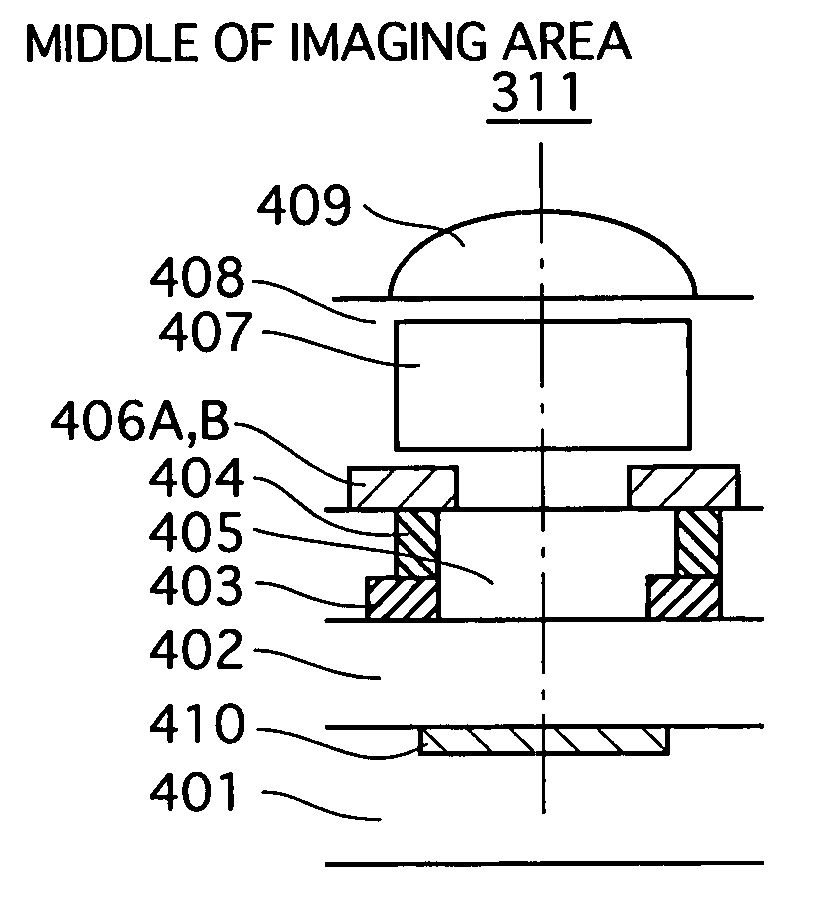Solid-state imaging device
a solid-state imaging and imaging device technology, applied in the field of solid-state imaging devices, can solve problems such as sensitivity shading, and achieve the effects of suppressing sensitivity shading, reducing sensitivity shading at the periphery of imaging area, and high performan
- Summary
- Abstract
- Description
- Claims
- Application Information
AI Technical Summary
Benefits of technology
Problems solved by technology
Method used
Image
Examples
embodiment 1
[0045] A MOS image sensor pertaining to an embodiment 1 of the present invention is characterized in that the position and shape of a metal layer in each pixel cell varies depending on the location of the pixel cell in an imaging area, so as to increase the amount of external light incident on a photodiode.
[0046] (1) Structure of MOS Image Sensor
[0047] Firstly, the structure of a MOS image sensor pertaining to the present embodiment is described. FIG. 3 is a circuit diagram showing the main structure of a MOS image sensor pertaining to the present embodiment.
[0048] As shown in FIG. 3, MOS image sensor 3 is provided with an imaging area 310, a vertical shift register 321, a horizontal shift register 322, reset lines 323, horizontal pixel selection lines 324, vertical selection transistors 325, a horizontal signal line 327, and vertical voltage input transistors 328.
[0049] A large number of pixel cells are two dimensionally arrayed in imaging area 310. Individual pixel cells 311 a...
embodiment 2
[0074] A MOS image sensor pertaining to the present embodiment is provided with generally the same structure as a MOS image sensor pertaining to embodiment 1, except that the pitch of the metal layers for ensuring electrical connectivity (equivalent to metal layers 406B in embodiment 1) differs depending on location in the imaging area. The present embodiment is described below, focusing exclusively on this difference.
[0075] (1) Division of Imaging Area
[0076] In the present embodiment, the imaging area is divided into a plurality of sub-areas, with the pitch of the metal layers for ensuring electrical connectivity being the same within respective sub-areas. This pitch becomes smaller the further the sub-area is from the middle of the imaging area.
[0077]FIGS. 6A and 6B are schematic views showing an exemplary division of the imaging area. FIG. 6A shows an example of the imaging area divided by concentric circles centered on the middle of the imaging area, while FIG. 6B shows an ex...
embodiment 3
[0081] Next, an embodiment 3 of the present invention is described. A MOS image sensor pertaining to the present embodiment is provided with generally the same structure as a MOS image sensor pertaining to embodiment 1, except that the pitch of the metal layers for ensuring electrical connectivity (equivalent to metal layers 406B in embodiment 1) differs depending on location in the imaging area. The present embodiment is described below, focusing exclusively on this difference.
[0082] (1) Structure of Pixel Cells
[0083] Firstly, the structure of pixel cells provided in a MOS image sensor pertaining to the present embodiment is described.
[0084]FIGS. 8A to 8D show the structure of a pixel cell provided in a MOS image sensor pertaining to the present embodiment. FIGS. 8A and 8C are a plan view and a cross-sectional view of the pixel cell located in the middle of the imaging area, while FIGS. 8B and 8D are a plan view and a cross-sectional view of the pixel cell located at the periphe...
PUM
 Login to View More
Login to View More Abstract
Description
Claims
Application Information
 Login to View More
Login to View More - R&D
- Intellectual Property
- Life Sciences
- Materials
- Tech Scout
- Unparalleled Data Quality
- Higher Quality Content
- 60% Fewer Hallucinations
Browse by: Latest US Patents, China's latest patents, Technical Efficacy Thesaurus, Application Domain, Technology Topic, Popular Technical Reports.
© 2025 PatSnap. All rights reserved.Legal|Privacy policy|Modern Slavery Act Transparency Statement|Sitemap|About US| Contact US: help@patsnap.com



